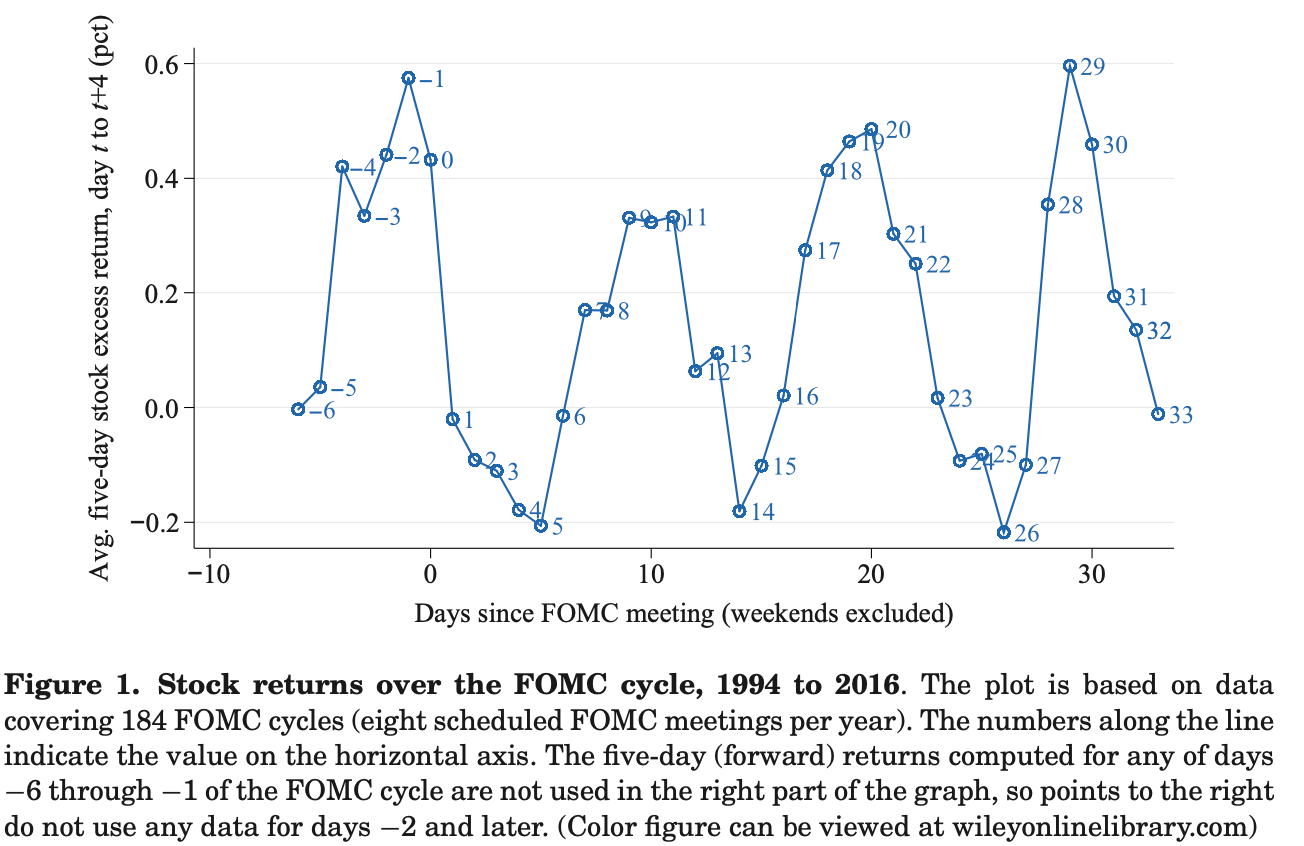💡 Takeaway:
Holding stocks only during even weeks of the FOMC cycle earns superior returns and lower volatility than buy-and-hold. Odd weeks yield negative average returns.
Key Idea: What Is This Paper About?
The paper identifies a novel and powerful anomaly: stock returns follow a biweekly cycle tied to FOMC meetings. Since 1994, the entire equity premium has been earned during weeks 0, 2, 4, and 6 following scheduled FOMC meetings. The effect is linked to monetary policy communication, especially informal leaks and Fed “put” behavior (responding to market stress with accommodation).
Economic Rationale: Why Should This Work?
📌 Relevant Economic Theories and Justifications:
- Fed Put: The Fed reacts to market declines with unexpected easing—driving positive stock returns in even weeks.
- Informal Communication Channel: Fed officials leak policy views via trusted journalists and private briefings—impacting markets before official releases.
- Uncertainty Reduction: The Fed lowers downside risk via promises to act, reducing the equity risk premium more than policy rates.
- Behavioral Inertia: Markets fail to fully price this calendar-based effect despite being tied to public information (FOMC calendar).
📌 Why It Matters:
This pattern transforms the equity premium puzzle into a monetary policy communication puzzle and provides a calendar-based trading strategy with strong theoretical and empirical support.
How to Do It: Data, Model, and Strategy Implementation
Data Used
- Period: 1994–2016
- Assets: U.S. equities (CRSP), Fed Funds futures, Treasury yields, global MSCI indices
- Fed Data: FOMC calendar, meeting transcripts, Board meetings, Fed speeches
- Returns: Daily and 5-day stock excess returns over T-bills
Model / Methodology
- Define FOMC cycle weeks:
- Week 0: days −1 to +3 relative to FOMC meeting
- Weeks 2, 4, 6: every second week post-meeting
- Regress returns on week dummies
- Test across time, market segments, and global indices
- Analyze Fed activity: intermeeting rate cuts, futures, board meetings, news leaks
- Estimate changes in the equity premium using Martin (2017)’s option-implied bound
Trading Strategy (FOMC Cycle Timing Strategy)
- Signal: Invest in equities during weeks 0, 2, 4, 6 of the FOMC cycle
- Hold Period: 5-day windows each even week
- Execution: Use SPY or S&P 500 futures for clean exposure
- Optional Enhancements:
- Scale exposure based on past week’s negative returns (Fed Put effect)
- Apply globally to MSCI World ex-US and EM indices
Key Table or Figure from the Paper

📌 Explanation:
- Plots 5-day rolling excess returns relative to the FOMC meeting.
- Sharp peaks occur in weeks 0, 2, 4, and 6, while returns in odd weeks are flat or negative.
- Entire equity premium is concentrated in these four weeks—a unique and replicable pattern.
Final Thought
💡 The Fed doesn’t just move markets on meeting days—it shapes the entire return cycle. 🚀
Paper Details (For Further Reading)
- Title: Stock Returns over the FOMC Cycle
- Authors: Anna Cieslak, Adair Morse, Annette Vissing-Jorgensen
- Publication Year: 2019
- Journal/Source: Journal of Finance
- Link: https://doi.org/10.1111/jofi.12818
